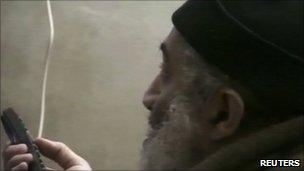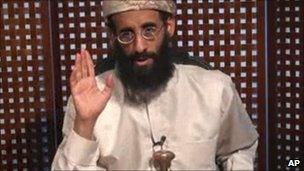Bin Laden: US now in control of al-Qaeda image
- Published

In the footage, Bin Laden looks considerably frailer than earlier images
An old, frail-looking man sits slouched on a floor, a television remote control in his hand.
He strokes his grey beard and rocks gently as he watches himself on the screen.
The man is Osama Bin Laden, captured on a tape that the US government says Navy Seals brought back with them from their mission in Abbottabad.
The Pentagon describes the results of the raid, during which US soldiers killed the world's most wanted man, as "the largest trove of information ever obtained from a single source".
The Pentagon, obviously, has a complete monopoly over the information, and is choosing what it wants the public to see very carefully.
No audio, no context and no explanation have been provided for the choice of clips that the Pentagon decided to release, nor was there any other information about whether or not they have any further footage.
Tarnished image
But, by showing a frail and weak Bin Laden, the US is undoubtedly trying to tarnish the image of the al-Qaeda leader in the eyes of his supporters around the world.
BBC Security Correspondent Frank Gardner on the significance of the new material
The five clips released by Pentagon on Saturday prove more that it possesses such material, rather than that it is a source of new information.
They show a more familiar Osama Bin Laden sitting against a plain background, speaking straight into the camera, his face lively and animated.
It is the same man who often issued video statements both to his enemies and supporters, although in three of the video clips he is rehearsing rather than delivering the actual speeches.
Command and control
The clips offer no major revelations, but the US government says that other data in their hands proves that, until the day he died, Bin Laden was in charge of al-Qaeda operations and that his compound in Abbottabad was a control-and-command centre for the organisation.
The Pentagon says that "the largest collection of terrorist material ever" also reveals what US counter-terrorism officials have been trying to establish for years - the role that Osama Bin Laden played in the operations of regional affiliates of his organisation, such as the Yemen-based al-Qaeda in the Arabian Peninsula.
Having for years assumed that the organisation operated for the most part independently, Pentagon officials now say that Bin Laden did play a significant role in its activities.

Anwar al-Awlaki is a radical Yemen-based preacher seen as a key operative
If true, his death could be a big blow to a group which sent the so-called "underpants bomber" to blow up a plane over Detroit, and which Washington views as the biggest threat to its homeland security.
The Pentagon does not explain details of how, if at all, material gathered in Pakistan will affect the US fight against al-Qaeda elsewhere.
While Mr Obama got his man, plenty more remain on the wanted list - including Anwar al-Awlaki, a US-born cleric based in Yemen whom the Pentagon has described as more dangerous than even Bin Laden.
On Thursday, less than a week after Bin Laden's death, the US launched a drone strike on a remote area of Yemen in a suspected attempt to kill Mr Awlaki. Sources in Yemen confirm that the attack took place but say that only two low-ranking militants were killed.
It is not clear whether the drone attack was linked to information found in Bin Laden's compound but the timing is certainly interesting.
The US drone strike infuriated hundreds of thousands of demonstrators in Yemen, who have been calling for the resignation of Washington's ally in its war on terror - President Ali Abdullah Saleh.
Protesters there accuse Mr Saleh of allowing the attack in exchange for support that he desperately needs.